Differential responses in human striatum and prefrontal cortex to changes in object and rule relevance
- PMID: 14762131
- PMCID: PMC6793591
- DOI: 10.1523/JNEUROSCI.4312-03.2004
Differential responses in human striatum and prefrontal cortex to changes in object and rule relevance
Abstract
Event-related functional magnetic resonance imaging was used to measure blood oxygenation level-dependent responses in 16 young healthy human volunteers during performance of an attentional switching task. The task allowed the separate investigation of lower-order switching between concrete objects and higher-order switching between abstract task rules. Significant signal change in the ventral striatum was demonstrated on trials when subjects switched between objects but not when subjects switched between abstract task rules. In contrast, signal change in the lateral prefrontal cortex (PFC) was observed during all switch trials. The switch-related responses were not contaminated by task difficulty, because the greatest signal change was observed during the relatively easy switch trials, which required both lower-order and higher-order switching at the same time. The present data suggest that mechanisms of inhibitory response control in frontostriatal systems are organized according to distinct levels of abstraction. Specifically, the response selection computation carried by the ventral striatum, which projects to the orbitofrontal cortex and the medial PFC, is restricted to the transformation of concrete stimulus exemplar information into motor responses, whereas the adaptive function of the lateral PFC extends to the transformation of abstract task-rule representations into action.
Figures





References
-
- Alexander G, DeLong M, Strick P (1986) Parallel organisation of functionally segregated circuits linking basal ganglia and cortex. Annu Rev Neurosci 9: 357–381. - PubMed
-
- Asaad WF, Rainer G, Miller EK (1998) Neural activity in the primate prefrontal cortex during associative learning. Neuron 21: 1399–1407. - PubMed
-
- Brett M, Anton J-L, Valabregue R, Poline J-B (2002) Region of interest analysis using an SPM toolbox. NeuroImage 16: 2.
-
- Brown V, Bowman E (2002) Rodent models of prefrontal cortical function. Trends Neurosci 25: 340–343. - PubMed
Publication types
MeSH terms
Grants and funding
LinkOut - more resources
Full Text Sources
Miscellaneous
